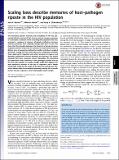| dc.contributor.author | Barton, John P. | |
| dc.contributor.author | Kardar, Mehran | |
| dc.contributor.author | Chakraborty, Arup K. | |
| dc.date.accessioned | 2015-08-05T13:32:23Z | |
| dc.date.available | 2015-08-05T13:32:23Z | |
| dc.date.issued | 2015-02 | |
| dc.date.submitted | 2014-08 | |
| dc.identifier.issn | 0027-8424 | |
| dc.identifier.issn | 1091-6490 | |
| dc.identifier.uri | http://hdl.handle.net/1721.1/98023 | |
| dc.description.abstract | The enormous genetic diversity and mutability of HIV has prevented effective control of this virus by natural immune responses or vaccination. Evolution of the circulating HIV population has thus occurred in response to diverse, ultimately ineffective, immune selection pressures that randomly change from host to host. We show that the interplay between the diversity of human immune responses and the ways that HIV mutates to evade them results in distinct sets of sequences defined by similar collectively coupled mutations. Scaling laws that relate these sets of sequences resemble those observed in linguistics and other branches of inquiry, and dynamics reminiscent of neural networks are observed. Like neural networks that store memories of past stimulation, the circulating HIV population stores memories of host–pathogen combat won by the virus. We describe an exactly solvable model that captures the main qualitative features of the sets of sequences and a simple mechanistic model for the origin of the observed scaling laws. Our results define collective mutational pathways used by HIV to evade human immune responses, which could guide vaccine design. | en_US |
| dc.description.sponsorship | Ragon Institute of MGH, MIT and Harvard | en_US |
| dc.language.iso | en_US | |
| dc.publisher | National Academy of Sciences (U.S.) | en_US |
| dc.relation.isversionof | http://dx.doi.org/10.1073/pnas.1415386112 | en_US |
| dc.rights | Article is made available in accordance with the publisher's policy and may be subject to US copyright law. Please refer to the publisher's site for terms of use. | en_US |
| dc.source | National Academy of Sciences (U.S.) | en_US |
| dc.title | Scaling laws describe memories of host–pathogen riposte in the HIV population | en_US |
| dc.type | Article | en_US |
| dc.identifier.citation | Barton, John P., Mehran Kardar, and Arup K. Chakraborty. “Scaling Laws Describe Memories of Host–pathogen Riposte in the HIV Population.” Proc Natl Acad Sci USA 112, no. 7 (February 2, 2015): 1965–1970. | en_US |
| dc.contributor.department | Institute for Medical Engineering and Science | en_US |
| dc.contributor.department | Massachusetts Institute of Technology. Department of Biological Engineering | en_US |
| dc.contributor.department | Massachusetts Institute of Technology. Department of Chemical Engineering | en_US |
| dc.contributor.department | Massachusetts Institute of Technology. Department of Chemistry | en_US |
| dc.contributor.department | Massachusetts Institute of Technology. Department of Physics | en_US |
| dc.contributor.department | Ragon Institute of MGH, MIT and Harvard | en_US |
| dc.contributor.mitauthor | Barton, John P. | en_US |
| dc.contributor.mitauthor | Kardar, Mehran | en_US |
| dc.contributor.mitauthor | Chakraborty, Arup K. | en_US |
| dc.relation.journal | Proceedings of the National Academy of Sciences | en_US |
| dc.eprint.version | Final published version | en_US |
| dc.type.uri | http://purl.org/eprint/type/JournalArticle | en_US |
| eprint.status | http://purl.org/eprint/status/PeerReviewed | en_US |
| dspace.orderedauthors | Barton, John P.; Kardar, Mehran; Chakraborty, Arup K. | en_US |
| dc.identifier.orcid | https://orcid.org/0000-0003-1467-421X | |
| dc.identifier.orcid | https://orcid.org/0000-0003-1268-9602 | |
| dc.identifier.orcid | https://orcid.org/0000-0002-1112-5912 | |
| mit.license | PUBLISHER_POLICY | en_US |
| mit.metadata.status | Complete | |
